2021-07-22
On July 22, 2021, the World Tourism Alliance Members’ Day 2021 organized by Harbin Municipal Bureau of Culture, Broadcasting, Television and Tourism, a member of WTA, was held in Harbin, Heilongjiang Province, China. Centering around the theme of “Festival Brands Building and City Tourism Development”, experts and scholars from the members of WTA including Harbin Municipal Bureau of Culture, Broadcasting, Television and Tourism, the School of Tourism Management at Sun Yat-sen University, UnionPay International, Spring Tour and Tuniu.com conducted interaction and communication with over 100 guests present.
On the WTA Members’ Day, Zhang Xiaoming, professor and doctoral supervisor of the School of Tourism Management at Sun Yat-sen University, gave a lecture titled “Festival and the Image Construction of Urban Destination”. From the perspective of communication semiotics, and based on the information about major tourist source cities in China on paper media and We Media platforms, he revealed the relevance of festivals in Harbin and its image as a tourism destination, further explored the ways to enhance the image of the city as a tourism destination through festival branding considering other typical cases, and put forward relevant suggestions.
Sharers | Zhang Xiaoming, Professor and Doctoral Supervisor of the School of Tourism Management at Sun Yat-sen University
Prepared Based on Recordings | World Tourism Alliance
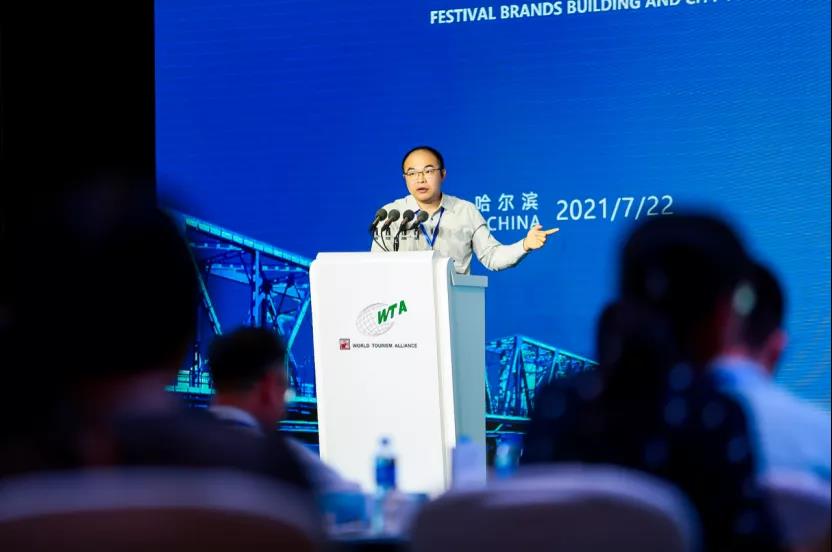
Great thanks to the World Tourism Alliance and the host, Harbin, for giving me this opportunity to share some views on festival tourism and the construction of city tourism destination image. My sharing may be to a great extent complementary to Director Lan’s speech which is from the perspective of supply side, and I wish it would provide you with some personal observations and thoughts.

When preparing this report, I studied the work reports of Harbin Municipal Government of many years, hoping to get some inspiration therefrom. I found a very interesting phenomenon, that is, in the work reports over the years, festivals were mainly mentioned from two perspectives: First, the perspective of city development positioning and brand. As you can in the part above the line in the image, there are several different statements. Second, the perspective of industrial development, that is, the part below the line, which uses more figures to express some positioning requirements for festival development. During the twenty years from 2001 to 2021, Harbin always has the clear target of being a “world-famous ice and snow tourism city” and “world ice and snow city”. That is to say, in fact, over the past 20 years, the image of Harbin as an ice and snow tourism destination city has been highly recognized by the government.
Then, from the perspective of the demand side and market – I myself being a part of it as a tourist – how is the tourism destination image of a city developed? This is a question I want to talk about below.
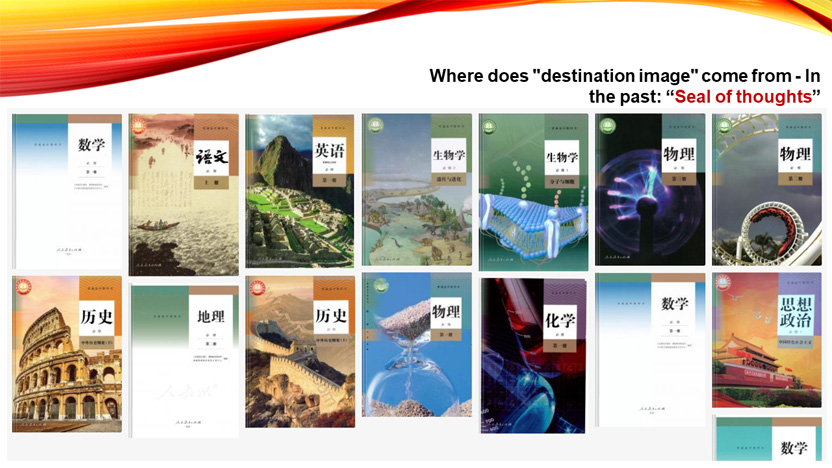
I want to give a very simple example: In the past, when the Internet economy was not so developed, the textbooks for primary and secondary schools provided basic information about many destination cities, which I called “seal of ideas”. For my generation – I studied in a primary school in 1980s – I remember very clearly the first text after the introduction of alphabet (Chinese Pinyin) like B, P, M, F, D, T, N and L in the first Chinese textbook. The first text is I Love Tiananmen Square in Beijing. The children got the basic impression about Tiananmen Square, Beijing and the capital from there, which is the “seal of ideas”. The images on the covers of these textbooks, including the Great Wall, the Colosseum in Rome, Machu Picchu, and many famous scenic spots and tourist cities, all attached the “seal of ideas” on us. However, great changes have taken place nowadays. The “seal of ideas” may still exist, but what influences us every day, generates new associations for us and arouses our curiosity? We have to say it is the current media environment, especially the mobile terminals and some software that is used by every person every day or even accompanies us 24 hours a day.
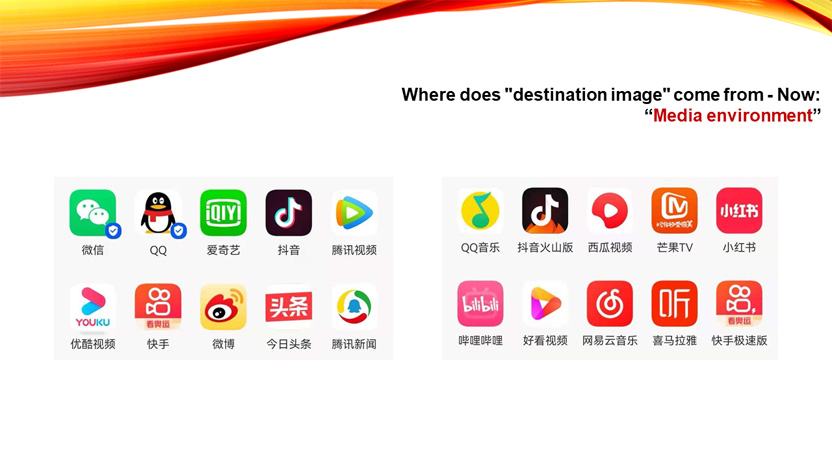
The 20 Apps listed here are all on an unofficial list of Top 100 Apps in 2019 in China, and they are all social software with functions like information transmission, communication and online forums. Next, my analysis will focus on how they build the image of a tourism destination.
There is a theory saying that the government, institutions, associations and enterprises convey the “projected image” to consumers, that is, transmitting the designed image, while the customer develops the “perceived image”. In the past, for a long time people thought that the journey from projection to perception was one-way. However, we find that in today’s media environment, the projection and perception together constitute the so-called “image construction”, which is very interesting. There are interactions and even circulation to some extent between them.
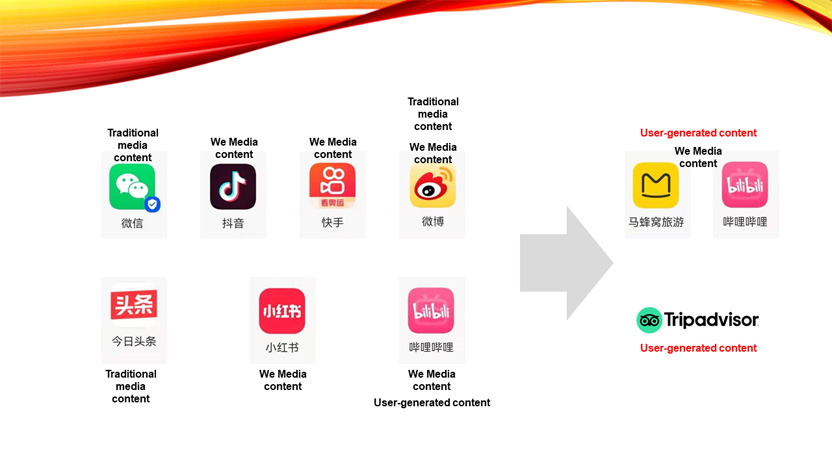
In the figure above, the part on the left of the gray arrow indicates some channels that the government and enterprises use to project the image at present, as well as some channels that the We Media uses to transmit information. The part on the right of the arrow is what we call “content generated by the user” from the perspective of consumers. They reflect some responses to the messages transmitted on the left. Next, I will introduce what we deliver and project, and then look at what the consumer, customer and potential tourists in the future receive, accept and even recognize.
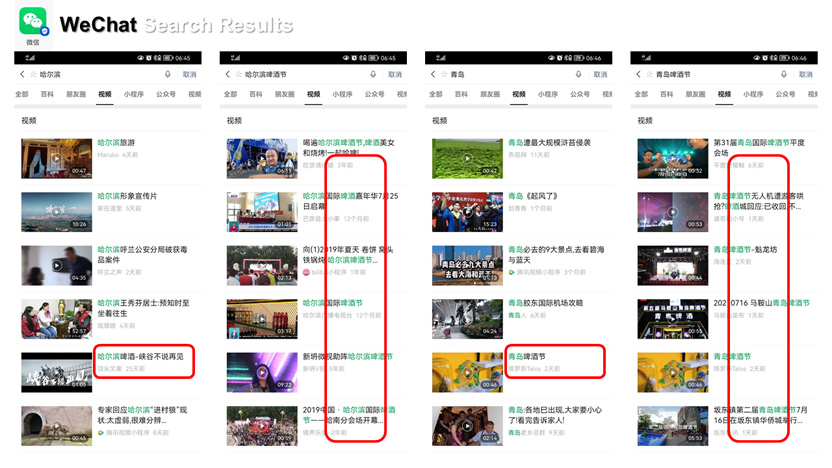
Let’s look at WeChat first. For comparison, I searched with “Harbin” and “Qingdao”, another very good tourist city in China. WeChat certainly has many different types of content. Let’s search for the “Videos”. We can see a contrast here, that is, the videos about Harbin beer festival – some released through official accounts and some through We Media accounts – were relatively old. The oldest one was released possibly five years ago, and the newest one was released twelve months ago. It means that probably we fail to make sufficient use of this channel. In comparison, the videos about Qingdao are relatively new, and some were released a few days ago. However, as my search was done on July 18th and today happened to be the first day of International Beer Festival of Harbin China, there may be new videos this week.
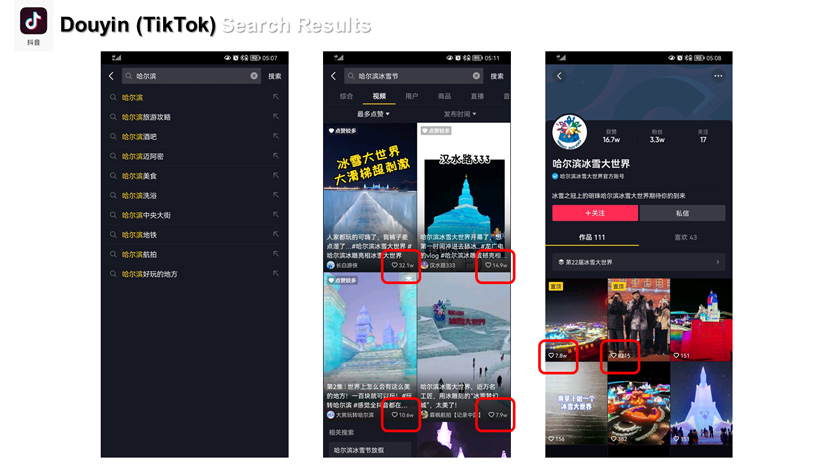
Let’s look at the second channel, Douyin (TikTok). There is a widespread opinion yet not verified with accurate data, “South Douyin and North Kuaishou”. When we search with the keyword “Harbin” directly, the hashtag topics that appear automatically – that is, the topics to which people pay more attention recently – actually do not include any content related to the festival, but include content related to other scenic spots in Harbin. It indicates that there are not many people who search for Harbin festivals through Douyin. In addition, when I searched with the keywords “Harbin Ice and Snow Festival”, some interesting contents appeared. The video with the most likes (321,000) at present is titled “Extremely Exciting Big Slide in Ice-Snow World” The video is very interesting for the presentation of the Ice and Snow Festival – it is not about a panoramic view showing the amazing sights shot with the drone? What’s it about? It is about a guy sitting on the ice slide directly, going down and screaming all the way for 40 seconds. (Video) It made the viewers very happy, and countless people clicked like. Can we see through the video what the most intuitive thing that festivals can bring to the audience is? It is excitement, joy, and a little bit of “carnival”. By comparison, in the official Douyin account of Harbin Ice-Snow World, the most popular video has about 73,000 likes, which is still far below the video released by that tourist. Of course, we know that such panoramic view is also needed in publicity.

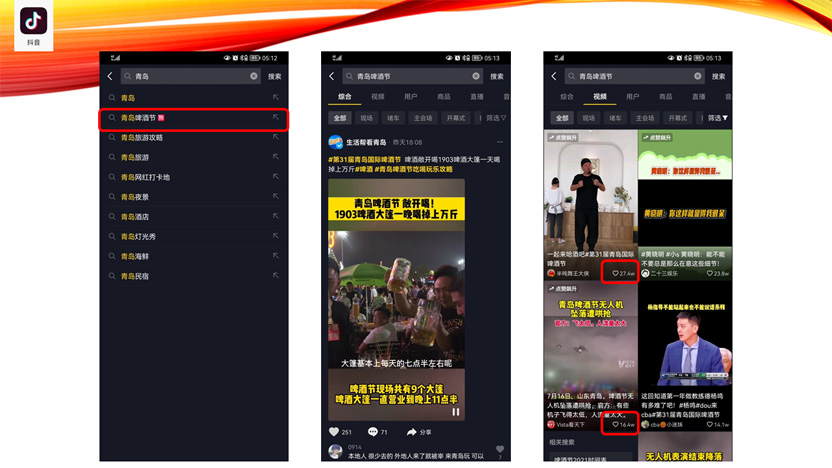
I also searched with “Beer Festival of Harbin China” and the results are very similar: Among the top four videos, three contain key words like “So excited girl in Budweiser shed” and “Dynamic dance”. If you click it – you all have mobile phones in your hands now, so you can search and open it immediately – you may find that the video lasting for dozens of seconds is about nothing but only a group of people dancing excitedly following the drums in the sheds in the beer festival. It is such emotions that spread very quickly and are highly recognized by viewers. According to my personal observation, the two most important festivals in Harbin do not have much historical and cultural burden like traditional festivals. Instead, they actually are fairly consistent with the pure pursuit of excitement, fun, happiness and joy of consumers at present. Therefore, such elements can be properly highlighted in future publicity of Harbin, so as to better respond to their recognition of the fun and value of festivals.
I also searched with “Qingdao”, and found that the hashtag topic of “Qingdao Beer Festival” appeared among the recommended results. Such relevance between destination and festival topic may be considered and strengthened in Harbin’s future online marketing. Of course, the mechanism of hashtag topic creation is different by software, and more detailed analysis is needed.


When searching in Kuaishou, you may get the similar results. The videos at the top are actually released by the users themselves, and convey more joyful messages.

As for Weibo, I would like to say a few more words. It is interesting that when you enter the word “Harbin”, among the hashtag topics that appear automatically, many are related to festivals. Now, Weibo has become more a platform for publishing and discussing instant messages. Just like the heavy rain in Zhengzhou and Henan several days before and in Hebei today, many messages asking for help and rescue that we saw, as well as the extremely exciting and moving scenes about rescue were released first through Weibo. Therefore, we can say that it is very powerful in transmitting dynamic messages. Then we will check how the dynamic messages about Harbin festivals are transmitted through it.

Let’s take a closer look at one of its functions – connection among “hashtag topics”. First, as an example, just as you see, there is “Strawberry Music Festival” on the previous slide, which is the most searched hot word among all recent festivals in Harbin. This is because of the impact of time on transmission – the hashtag topics will keep changing along with the change of people’s attention. Secondly, it is very interesting that the music festival is connected with stars participating in the festival, who have their own fans. After visiting Harbin, these people will convey the image of Harbin more broadly. For example, under one Weibo post of Jiulian Zhenren band, the second reply seems to have nothing to do with the festival itself, but is directly related to the feeling of Harbin -“The weather in Harbin is so comfortable, and what shocked me most is that the day breaks at 3:30 in the morning.” Such regional difference, in fact, is very attractive to tourists – The day doesn’t break so early in many other places in the country, right? In fact, this reply generated a new topic for the transmission of music festival messages, and some other people followed and liked it – there have been 21 likes so far, thus contributing to keeping the festival a hot topic.
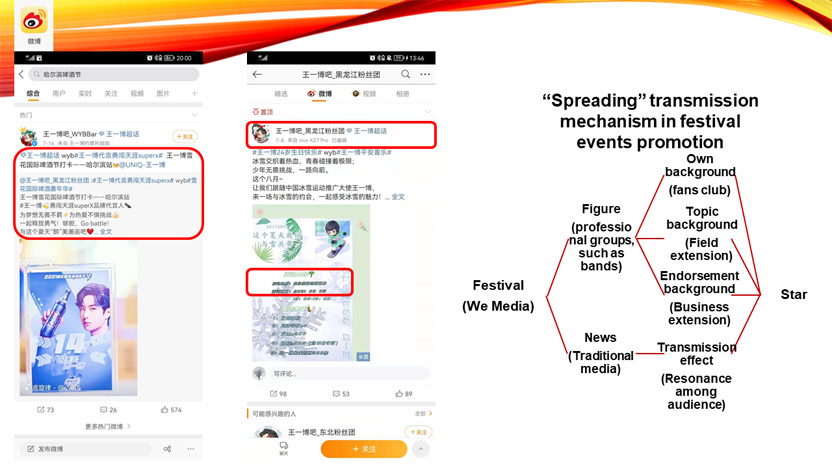
We may further check what other topics it may bring. When we search with “Beer Festival of Harbin China”, one hashtag topic is not our official beer festival, but a publicity program made by Snow Beer. However, as one of its recent spokespersons is Wang Yibo, who may be said to be the hottest star in China at present, the Harbin fan club and Heilongjiang fan club of Wang Yibo swarmed up, using their own accounts and fans to launch the second and third rounds of transmission. Consequently, Harbin’s city image and tourism image may be known to a larger audience.
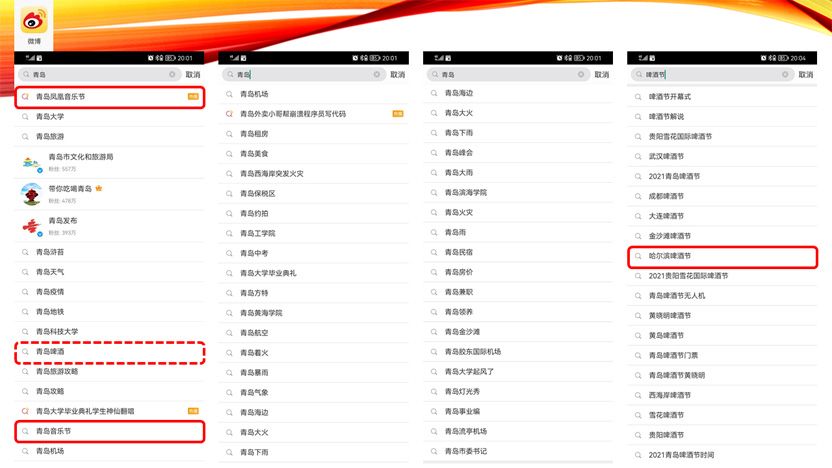
To sum up, we will find that actually the Internet – just as many sociologists said when it was born – has developed one of our social networks, and generates the “spreading” effect in the transmission of festival and destination image.
Besides, when I searched with “Beer Festival”, I found that “Beer Festival of Harbin China (or Harbin Beer)” and “Qingdao Beer Festival” were both among the results. Moreover, there were beer festivals of Chengdu and many other member cities present today, all of which were at least on the list of Weibo, and became known to certain people.
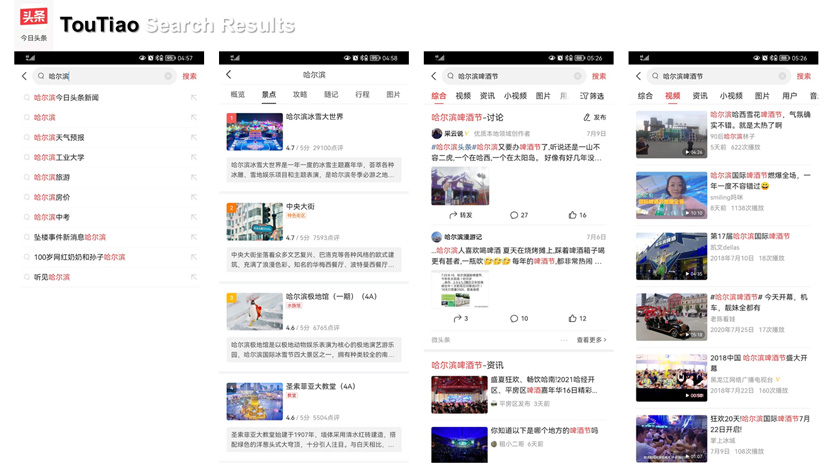

As to TouTiao, the case is different. Compared with the previous Apps characterized by dynamics and vitality, TouTiao feels more like a traditional news media. In particular, it seems that it promotes information transmission in the same manner as updated mainstream paper media. For example, many of its news titles are very simple, just saying things as they are, and seldom display the vitality and dynamics as we can see in the previous apps.

Xiaohongshu is quite interesting. When I searched in it, I found a topic called “20 Little Things We Must Do in Harbin”. What are these little things? – The title arouses people’s curiosity. Clicking in, I found that they were really 20 “small” things. None of them were “attending the Ice and Snow Festival”, “attending the beer festival” or “attending the Harbin Summer Music Concert”. Almost all of them were about scenic spots, and encouraging people to “tick off” them. We certainly know that “tick-off” is now an important “excuse” for many young people to travel. But what about festivals? Many festivals are seasonal, unlike other scenic spots in a city which we can accurately advertise them on the official homepage by the category. In fact, many young people come to destination cities because of the short-term strong attraction of a festival, so the systematic publicity of the festival may need to be strengthened in the future.
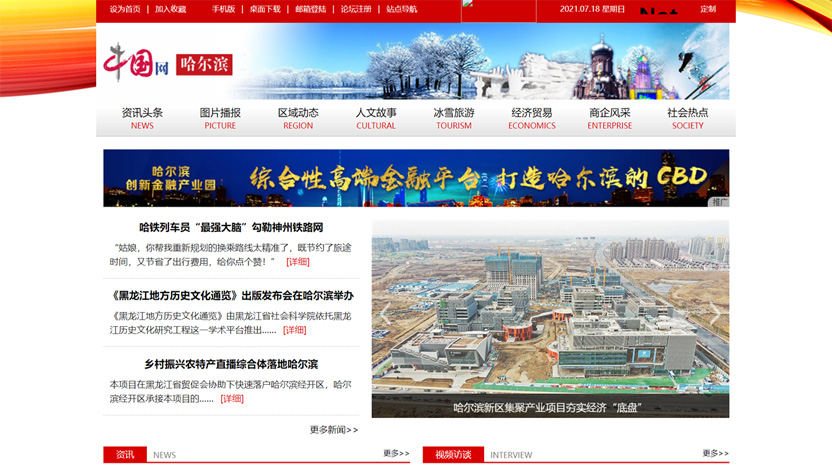

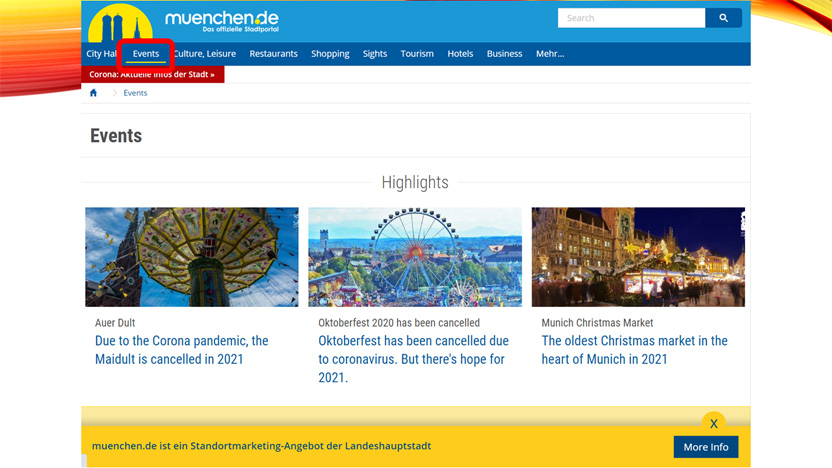
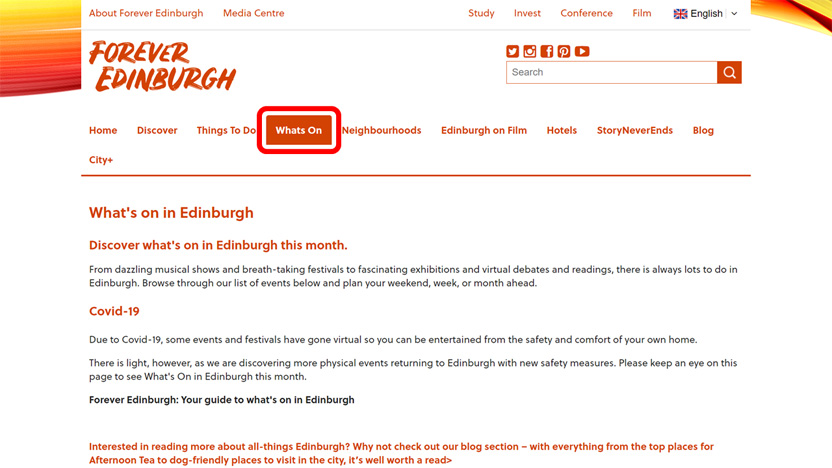
Let’s compare several official homepages. First of all, on the Harbin page on “China.com”, we have not seen that the festivals and exhibitions are placed as a category among the topics on the top line. However, Sydney has done it, and the category is called “events”. Munich has done the same. We know that the Munich Oktoberfest is one of the most famous festivals with a large number of tourists in the world. It is under the label “events”, which is before all other tourism activities such as culture, catering, shopping, sightseeing, etc. In other words, events – usually including festivals, exhibitions and games – are highly advocated by the city. There is also Edinburgh. When we open the page, we may find that although all events of the city have been stopped because of COVID-19, it still keeps the label “What’s on”, which means what is happening and what activities are being held. It also shows that the city still attaches great importance to such a separate category including festivals. All in all, festival events, whether as means to attract tourists or build the destination image of this city, have an unexceptional status for these famous foreign tourist cities, and have been specially promoted.
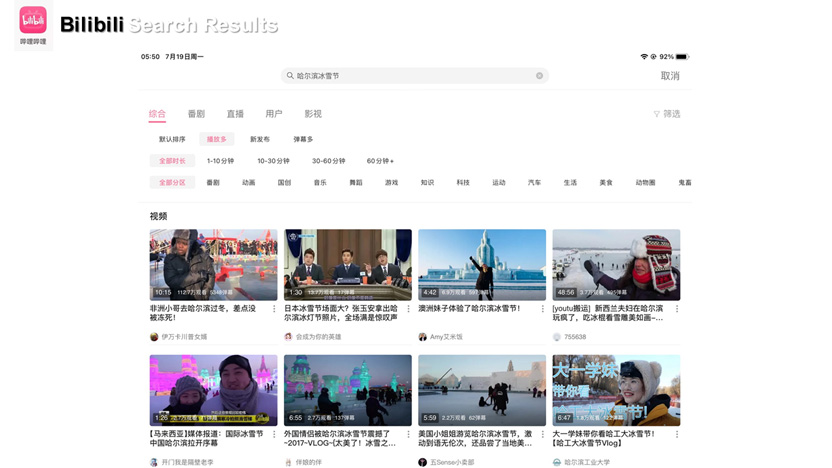
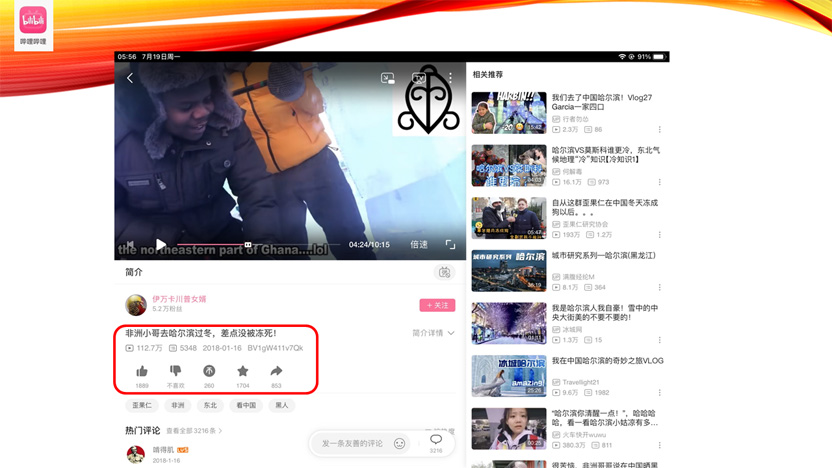
Finally, let’s take a look at Bilibili (a video website). It has about 50 million active users, and most of them are youth, maybe between 15 and 25 years old. They are where our future lies. The dynamics and excitement of festival activities are exactly what the youth especially cares when choosing tourist destinations. Therefore, it is very interesting that when you searched with “Harbin Ice and Snow Festival” in Bilibili, the first video was uploaded by a black boy about 20 years old in 2018 – such users uploading the video is called “Up owner”. He made a video of his feeling in Harbin Ice and Snow Festival, and now has got 1889 likes – and no dislikes, which is amazing. Is it because the dislikes are too few to display or are really zero? Anyway, such case is very rare. In addition, there are 853 reposts, and the total views have reached 1.129 million. We can imagine that influenced by this video, the youth who have participated in video interaction will not only come themselves in the future, but also bring their children and their parents. Therefore, to some extent, this video helped Harbin to win the market of the youth who are about to form families and become the main consumer group.


I also searched with “Beer Festival” in Bilibili. Relatively speaking, Harbin’s advertisement – at least on such a platform – is possibly not enough. For example, the first video has only 667 views. Moreover, it was uploaded during the 2013 Bear Festival, indicating that very weak communication effect has accumulated over the years. More attention needs to be paid to this platform.
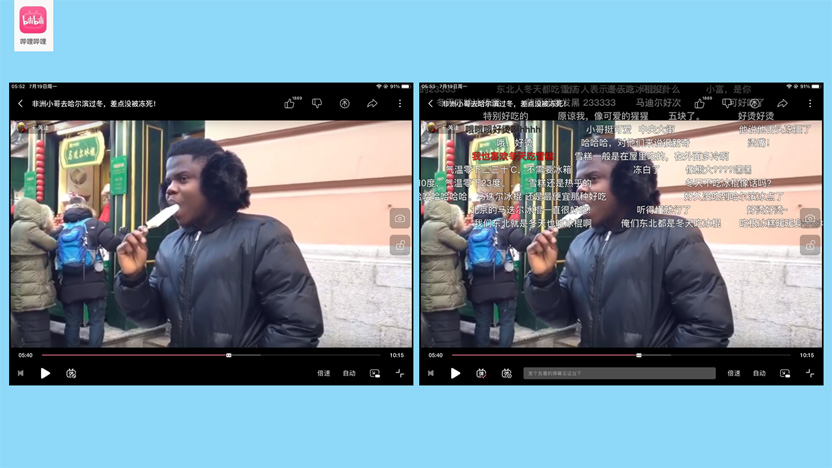
Next, I’d like to talk about the consumer’s reaction – that is, the “perceived image”- under the image projection above, and the level of recognition among consumers. Let’s look at the Bilibili again. It has a lot of user-generated content. In fact, the video of that black boy is also user-generated, but we are more concerned about its unique way of reflecting the audience’s views, which is called “bullet screen”, that is, a viewer can immediately send his/her opinions and comments to the video-playing screen, and those who watch this video later can send their opinions and comments again. The comments in “bullet screen”, to a great extent, represent the first reaction of a potential consumer when watching the video. Is it possible to become a new “seal of ideas” in a certain sense? I think it deserves further study.
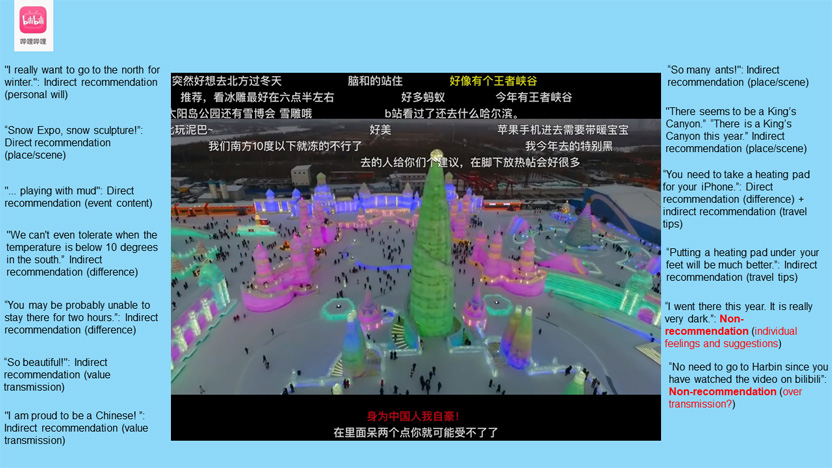
I roughly analyzed the bullet screen words appearing in a representative scene of this video. Actually, we can interpret the direct or indirect recommendation behind all those words. For example, “I really want to go to the north for winter” or “we can’t even tolerate when the temperature is below 10 degrees in the south”. The expression of such difference will give tourists an urge to go there. Similar words include “So beautiful!” and “I am proud to be a Chinese”. In addition, there is such a link: “There seems to be a King’s Canyon” – “King’s Canyon” is a group of ice sculptures in a very popular game, and such words will also stimulate and urge a specific group of people. Of course, at the lower right corner of the screen, there are also two non-recommendation comments, especially the second one which says: “Having seen such a good video, do I still need to go to Harbin personally?” It is a reminder to us: should we keep something in the advertisement and package some wonderful things in a relatively subtle and mysterious manner, instead of fully showing all of the beauty on the Internet? All what we do aims to attract people and arouse their motivation to travel, which is the most important thing.

Let’s look at a more typical perceived image, that is, this important scenic spot label generated on Mafengwo.cn. In the list of recommended scenic spots in Mafengwo.cn, we can also see that the Ice-Snow World ranks first. It is an important base for the Ice and Snow Festival or the winter festival tourism. In fact, the city image of Harbin as an ice and snow tourism destination is really outstanding, and the labels related to “ice and snow” and “winter” are very conspicuous, which shows the great achievement of holding ice and snow festivals for decades.

Let’s take a look at a foreign travel portal – Tripadvisor.cn. It is particularly interesting that it puts festivals and scenic spots together as “attractions” for appraisal, and we are very happy to see that among the more than 200 attractions in Harbin, the Ice-Snow World ranks first, while the Ice and Snow Festival ranks seventh.
Moreover, the visitors’ comments on the attraction page are very interesting. Here is a comment – possibly about recollection – made on February 8 last year by a tourist from Israel. What did he say? “The main highlights of Harbin are of course the three scenic spots of the Ice and Snow Festival.” It directly links the festival with the scenic spots resources of the destination, and the effect of such image transmission is very obvious. The second comment that deserves attention is made by a British, and she said something very special: “Even though the tickets are expensive, it is very amazing and still worth a visit. At sunset, it is just a winter wonderland.” I think all tourism professionals in Harbin will have a great sense of accomplishment seeing such appraisal.
Finally, I would like to share some very crude inspirations. On the one hand, I think we can learn from three valuable lessons of Harbin:
First, care and spread the festival spirits in festival advertisement;
Second, strengthen the connection between festivals and destination scenic spots in advertisement;
Third, integrate the centers and origins of any re-transmission, including stars, online celebrities and Up owners, with a more open mind, to develop better relevance recognition.
On the other hand, destination cities like Harbin may need to consider the following three factors while making use of festival activities to spread their images:
First, enhance the “pertinence” of hashtag topics in each App platform – as I just presented, after the keyword is entered in the search box, festivals will be directly presented;
Second, increase the “conspicuity” of the events in main advertisement platforms, just as the traditional website homepage mentioned above in my sharing;
Third, enhance the “sense of entertainment” in the tone of transmission content.
That’s what I want to share today. Many thanks to the World Tourism Alliance and the organizer, Harbin, for providing this opportunity for exchange.
Thank you!
